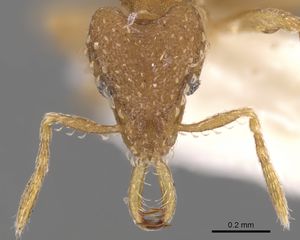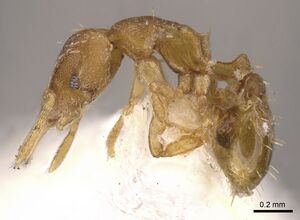Strumigenys shaula
| Strumigenys shaula | |
|---|---|

| |
| Scientific classification | |
| Kingdom: | Animalia |
| Phylum: | Arthropoda |
| Class: | Insecta |
| Order: | Hymenoptera |
| Family: | Formicidae |
| Subfamily: | Myrmicinae |
| Tribe: | Attini |
| Genus: | Strumigenys |
| Species: | S. shaula |
| Binomial name | |
| Strumigenys shaula Bolton, 1983 | |
Known from a small number of collections. Habitats include Bushclumps in Sekhukhune Montane Grassland, Lydenburg Thornveld, and Miombo woodland/forest, with specimens obtained from pitfall traps and litter-sampling.
Identification
Bolton (1983) - A member of the pretoriae complex in the Strumigenys arnoldi-group. The closest relative of shaula appears to be Strumigenys pretoriae, but in that species the eyes are very large, the head has uniform scale-like pilosity and the pronotal humeri lack flagellate hairs. In the closely related Strumigenys dromoshaula from Burundi the extension of the preocular notch onto the ventral surface of the head forms a broad shallow dish-like impression with feebly defined rounded margins, rather than the narrow groove with sharp edges seen in shaula. In dyshaula the preocular notch is reduced, small and shallow in full-face view and not extended onto the ventral surface of the head. S. shaula also shows some relationship with the West African Strumigenys rufobrunea but the latter species is smaller, has longer scapes, smaller eyes, more sinuate upper scrobe margins and a petiole node which in dorsal view is only marginally broader than long, as well as the dental character given in the key.
Keys including this Species
Distribution
Latitudinal Distribution Pattern
Latitudinal Range: -11.00842° to -25.17778°.
| North Temperate |
North Subtropical |
Tropical | South Subtropical |
South Temperate |
- Source: AntMaps
Distribution based on Regional Taxon Lists
Afrotropical Region: United Republic of Tanzania, Zimbabwe (type locality), Zimbabwe (type locality).
Distribution based on AntMaps
Distribution based on AntWeb specimens
Check data from AntWeb
Countries Occupied
| Number of countries occupied by this species based on AntWiki Regional Taxon Lists. In general, fewer countries occupied indicates a narrower range, while more countries indicates a more widespread species. |

|
Estimated Abundance
| Relative abundance based on number of AntMaps records per species (this species within the purple bar). Fewer records (to the left) indicates a less abundant/encountered species while more records (to the right) indicates more abundant/encountered species. |

|
Biology
Castes
Worker
Images from AntWeb
   
| |
| Holotype of Strumigenys shaula. Worker. Specimen code casent0900600. Photographer Will Ericson, uploaded by California Academy of Sciences. | Owned by NHMUK, London, UK. |
Nomenclature
The following information is derived from Barry Bolton's Online Catalogue of the Ants of the World.
- shaula. Strumigenys shaula Bolton, 1983: 392 (w.) ZIMBABWE. See also: Bolton, 2000: 605.
Unless otherwise noted the text for the remainder of this section is reported from the publication that includes the original description.
Description
Worker
Holotype. TL 2.2, HL 0.57, HW 0.44, CI 77, ML 0.25, MI 44, SL 0.29, SI 66, PW 0.28, AL 0.56.
Mandibles in full-face view weakly bowed outwards. Apical fork of each mandible with 2 teeth, without intercalary teeth or denticles. Pre apical armament of 2 teeth on each mandibular blade, both situated close to the apex, the proximal longer than the distal in each case. Space separating the proximal and distal preapical teeth distinctly shorter than the length of the distal tooth. Upper scrobe margins bordered by a narrow rim or flange throughout their length, evenly divergent posteriorly and approximately straight rather than sinuate. Eyes relatively large, plainly visible in full-face view, the maximum diameter of the eye 0.18 X HW, and in full-face view the length of the eye distinctly much greater than the maximum width of the scape. Preocular notch present and conspicuous, the anteriormost portion of the eye detached from the side of the head. Preocular notch continued onto ventral surface of head as a deep transverse groove which is narrower than the: maximum diameter of the eye and has approximately parallel quite sharply defined margins. Antennal scapes feebly bent in the basal third and slightly thickened medially, the leading edges with a row of apically curved spoon-shaped hairs. Ground-pilosity of cephalic dorsum of inconspicuous small curved hairs, the upper scrobe margins fringed by a row of much larger spoon-shaped hairs which are curved anteriorly. Dorsum of head with 6 standing hairs arranged in a transverse row of 4 close to the occipital margin and a more anteriorly situated pair. Cephalic dorsum shallowly reticulate-punctate. Pronotal humeri each with a single fine flagellate hair, the mesonotum with a single pair of standing hairs. Ground-pilosity of dorsal alitrunk of minute hairs which are closely applied to the surface. With the alitrunk in profile the posterior portion of the mesonotum only very feebly depressed behind the level of the hairs, the metanotal groove weakly impressed. Propodeal teeth sub tended by infradental lamellae which are about half as wide as the length of the tooth. Sides of propodeum superficially punctate, the pleurae mostly smooth except for some peripheral fine punctures which are best developed laterodorsally. Sides of pronotum with traces of punctate sculpture anteriorly and dorsally. Pronotal dorsum finely longitudinally rugulose, the spaces between the rugulae inconspicously punctulate. Remainder of dorsal alitrunk reticulate-punctate. Dorsum of petiole node narrow from front to back and very broad, finely punctate; the postpetiole smooth. Spongiform appendages of pedicel segments moderately developed, the subpetiolar process narrower than the depth of the peduncle at its midlength. Ventral and lateral spongiform lobes of postpetiole well developed, the former only marginally larger than the latter and about equal in size to the exposed area of the postpetiolar disc in profile. In dorsal view the postpetiole with a narrow laminar posterior transverse strip; on the sides projecting spongiform material restricted to the posterior halves. Base of first gastral tergite with a laminar transverse strip from which the sharply defined basigastral costulae arise. Petiole, postpetiole and gaster dorsally with stout standing hairs which are thickened to feebly clavate apically. Colour yellowish brown to light brown.
Paratypes. TL 2.1-2.3, HL 0.54-0.58, HW 0.42-0.47, CI 75-81, ML 0.25-0.27, MI 44-47, SL 0.27-0.31, SI 64-69, PW 0.27-0.31, AL 0.52-0.58 (3 measured). As holotype.
Type Material
Holotype worker, Zimbabwe: Gwebi, 1971, acc. 14746, pitfall trap (K. J. Wilson) (The Natural History Museum). Paratypes. 3 workers with same data as holotype (BMNH; Museum of Comparative Zoology).
References
- Bolton, B. 1983. The Afrotropical dacetine ants (Formicidae). Bulletin of the British Museum (Natural History). Entomology. 46:267-416. (page 392, worker described)
- Bolton, B. 2000. The ant tribe Dacetini. Memoirs of the American Entomological Institute. 65:1-1028.

